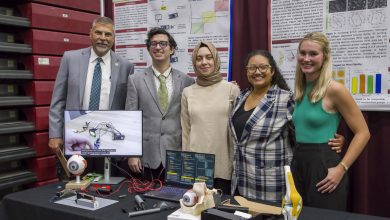Safe and Secure Airfields

A system created by Florida Institute of Technology alumni that integrates radar with long-range cameras and smart software to improve safety and security at airfields is coming to the U.S. marketplace after a successful, multiyear deployment overseas.
Security Radar Integrators President and Founder Dan Flynn ’84 and John Dutton ’84 developed Airfield Radar System (ARS), which automatically monitors an airfield, evaluates all moving objects and responds accordingly.
The ARS radar has been widely deployed in Europe, and as the Federal Communications Commission continues to evaluate the system for airports in the U.S., the Rockledge, Fla.-based company known as SRI has successfully field tested it at 10 commercial and general aviation airports in the U.S.
Among the test sites is Valkaria Airport, managed by Steve Borowski ’85 MBA. “The ARS system shrinks the airfield down to the size of a computer screen, and then watches it for you,” Borowski said. “My initial interest was to track and record video of birds, which it did well. But then over the 30-day test, we also saw tremendous capabilities in overall safety and security.”
Borowski was one of several Florida Tech alumni SRI tapped for their expertise, including several graduates of FIT Aviation.
“FIT Aviation is happy to work with a local company who is developing technology that can help us all,” said Ken Stackpoole, vice president of FIT Aviation Programs.
And as Security Radar Integrators develops new features for ARS, its principals are working with Florida Tech’s electrical and computer engineering department to identify development tasks for engineering master’s degree and Ph.D. candidates.
ARS has been in use overseas for more than five years. Fourteen airports have adopted the radar in Europe and hundreds of ARS radars have been deployed for traffic monitoring and other uses.
ARS uses radar to see everything that moves, from planes and vehicles to people and wildlife. It then uses software to evaluate whether the movements are normal activity or a potential problem. Based on the activity, the system responds by pointing a camera, recording video or triggering another response. If a deer is on the runway at night, for instance, the system can be configured to follow it with a thermal camera, wait 10 seconds, and then trigger a remote wildlife mitigation device to scare it away. If the problem persists, it can send a text message to a security officer to look at the live image on his smart phone. ARS can also monitor perimeter intrusions, speeding on ramps or in other areas, runway incursions and vandalism, with responses including lights and sirens and movement with gates and doors.
With 1,241 runway incursions and 11,000 wildlife strikes in 2013 alone, and 1,300 perimeter breaches since 2001, airside safety remains a work in progress.
“SRI has developed a system that combines radar, optics, wireless and advanced classification,” said Sam Kozaitis, head of Florida Tech’s electrical and computer engineering department.
Even as testing continues, some airports are in the process of buying the Airfield Radar System, Flynn said. And the company is continuing to reach out to aviation professionals and prospective users nationwide, as it exhibits at nine different conferences and events in 2014.
Learn more about Security Radar Integrators and the ARS system at www.sri-radar.com or by contacting President Dan Flynn at (321) 427-8873.





